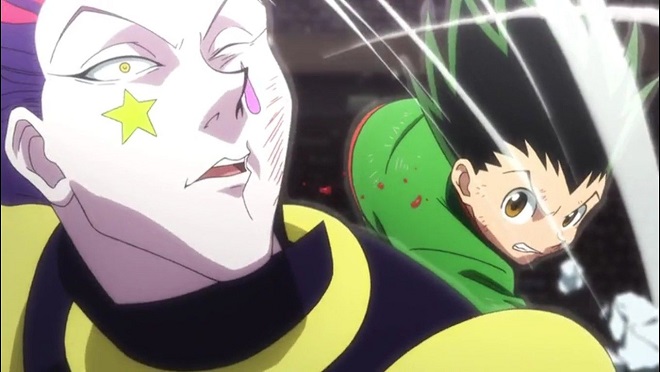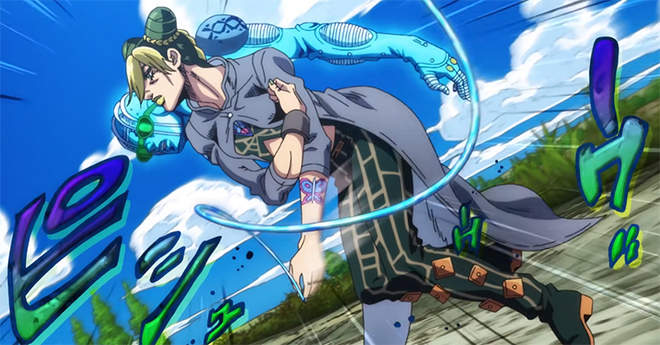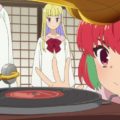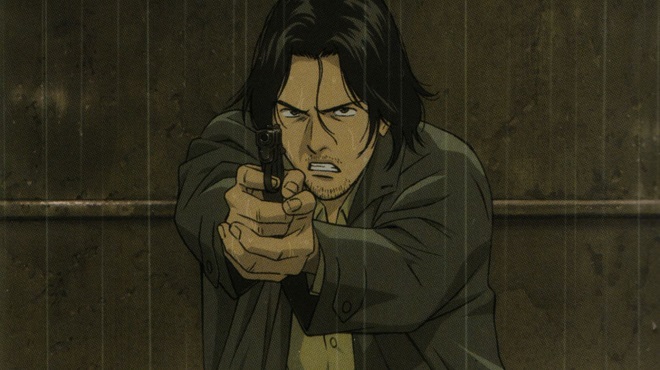Quarantine Control #144: Gon Wading in Stone Ocean

It is now a new year, making this the first Quarantine Control entry of 2023. But it’s not surprising that little has changed. COVID is still hanging around, which could be in a new dangerous form considering what’s going around in China now, because it has more mutations than Dragon Ball villains. The year has only changed a “little” because, well, this might be a bad one for celebrity and sports injuries. It would be pleasant to think the occurrences like Damar Hamlin’s dangerous collision and the attempt to take out Hawkeye are mere aberrations, but consider how previous years have gone.
Geoffrey Barnes
Hunter x Hunter (2011)
Source: Tubi (it’s on a LOT of services)
Episodes: 1-58 (from the Hunter Examination arc to the Phantom Troupe arc)

I’ve had too difficult a time preventing myself from thinking that Hunter x Hunter was a mere shonen stock series for years on end, given its art style and how popular some of them tend to be. I’d seen how it graced several “best of” lists from big sites that cover anime, saw mentions of it occasionally on my Twitter feed, and know damn well that art styles don’t always dictate franchise themes. But the art and genre combination were powerful enough for me to rule it out, and the somewhat-high episode count didn’t help. The praise finally convinced me to check it out, now that it’s so easy to do on a free (with short ad breaks) streaming service like Tubi. I’ve watched 58 episodes, consisting of three arcs, I’m ready to write about. If I ventured through that many, I surely must enjoy it.
This wasn’t the case at the start, however. Hunter x Hunter’s earliest moments wouldn’t be out of place at the start of any anime series aimed towards teenagers, with 12-year-old protagonist Gon Freecss (pronounced “Gone Freaks”) bidding his aunt (his parental guardian) adieu before venturing off to participate in the Hunter Examination. Gon hopes to locate his father Ging Freecss (pronounced “Jean Freaks,” yes), who similarly set out to become a Hunter. It’s at the examination when he meets the other key characters, including Killua, Kurapika, and Leorio, who all have their own reasons for participating to become Hunters themselves.
When I heard about how good the series gets, I knew those who said so weren’t talking about the Hunter Examination arc, though it’s hardly bad. The story uses this opportunity to introduce the main characters and establish their personalities, and provide occasional opposition and occasional stakes. This was the time when author Yoshihiro Togashi was considering what direction he’d eventually want the series to go in, while focusing on character development and worldbuilding. That writing and development are notably both good, to the point that it doesn’t need material like constant fights to keep it going along. But it’s certainly slower at the start than, say, Yu Yu Hakusho.
This continues into the Heavens Arena arc, the tournament which Gon and Killua enter to see how far they’ve come in a short time. This results in a battle with Hisoka, a powerful warrior introduced in the Hunter Examination arc with the appearance of a clown who, it turns out, is a dangerous transmuter. The fights are well animated, though it feels more like an extension of the prior arc in how Gon and Killua are still very much learning how to handle themselves in battle and are in the process of developing their abilities and personalities. It’s still fun, though, especially with Gon’s naïve stubbornness in battle, which makes him far more endearing than the usual not-that-smart shonen hero.
The Phantom Troupe arc is where the series shows its potential, the point at which I fully understood where the praise emerged from. The more heroic characters from the Hunter Examination arc return to take on the well-developed villains in the titular Phantom Troupe. It took its time, but this is where the series truly comes into its own, and the animation quality jumps up with it.
Hunter x Hunter avoids a number of issues that tend to plague “stock” and “typical” shonen stories, but the key one it does suffer from is occasional pacing issues. Facets of the story can take several episodes to unravel, and the same applies to battles playing out. It’s nothing on par with more grievous offenders like Dragon Ball Z/Super or Naruto, thanks to the arcs tackling material that finished in the manga several years beforehand. The series also manages to keep the plot developments entertaining while they take their time, enough that it kept me wanting to watch just one more episode. It’s a good sign that I never felt like dropping it.
I still have plenty more to watch, including the lengthy Chimera Ant arc, one nearly as long as the Frieza saga in DBZ. I wasn’t able to wrap up the Greed Island arc before giving my thoughts here, but it’s a great sign when I’ve remained interested in the series for just over 70 episodes at this point.
Hopefully Togashi finds a good pace to work at soon, whose health issues from working on the series have been very publicized over the last few years. If he reaches a point where he can no longer continue, a significant possibility, I hope he’s making backup plans to either pass the series to staffers or hand the anime production crew an outline of his future ideas. Health matters more than a manga or anime story, so hopefully he can recover soon.
Angela Moseley
JoJo’s Bizarre Adventure: Stone Ocean (2022)
Source: Netflix
Episodes: 38

Jojo’s Bizarre Adventure is a series that largely flew under the radar, save for those who managed to watch the 1990s Stardust Crusaders OVAs or played the Capcom fighting game, JoJo’s Venture. Fans never received official manga translations for the hugely popular story and numerous sequels that had been ongoing since 1987. For years so many pop culture references and homages to this series weren’t completely understood. That changed in 2012 when David Production, a smaller animation studio, adapted JoJo’s Bizarre Adventure: The Animation. Unlike the original 1990s OVA, this series focused on Phantom Blood and Battle Tendency, the first two parts of the JoJo story. The adaptation did well enough to receive more parts, or seasons. Roughly every three to four years David Production has released more JoJo, until we’ve finally reached part 6 of the story, JoJo’s Bizarre Adventure: Stone Ocean.
Jolyne Cujoh is a 19-year-old who’s previously had brushes with the law. She gives her mother grief with her actions, and her father, Jotaro Kujo has largely been absent in her life. Jolyne is now trying to lead a clean life, but misfortune quickly befalls her when her boyfriend runs over and kills a pedestrian. She’s considered an accessory to the crime, and her boyfriend pins the entire incident on her. The court finds her guilty and Jolyne is sent to Florida’s infamous Green Dolphin Street Prison. There she receives a gift from her father in the form of a broach. She accidentally stabs herself with the item and awakens to the power of her own stand. She learns the prison is filled with other stand users and she has to battle to survive. Fortunately, she’s a quick learner and isn’t afraid to fight. Things take a turn for the serious when Jotaro visits her, they’re nearly killed. Jolyne quickly finds herself swept up in a huge plot set in motion by the followers of a powerful vampire named DIO.
While it is possible to watch a JoJo’s series without prior knowledge of previous parts, a lot of backstory is lost. A good example would be many anime critics insistence that newcomers to JoJo skip Phantom Blood and Battle Tendency and go straight to Stardust Crusaders. I disagree, as getting to know the entire Joestar bloodline via their adventures makes for fascinating insight to later series. In the case of Stone Ocean, to get the best enjoyment out of this series, Phantom Blood, Battle Tendency, Stardust Crusaders, and Diamond is Unbreakable are prerequisites. Golden Wind isn’t necessary, but the series I listed at least give you an idea of the villain’s motivations and their hatred of the entire Joestar bloodline.
I am consistently amazed at how each part of JoJo’s manages to maintain its level of bizarre. I thought Jolyne escaping from a prison would be a fairly standard tale, as these types of stories are routine in media. Add the weird power that stands give a user and manga artist Hirohiko Araki’s storytelling, and you have one of the most unique prison escape stories I’ve ever come across. I’m also surprised at how big of a role DIO plays in Stone Ocean despite having been killed way back in Stardust Crusaders. Yet we see him in various flashbacks with one of his most loyal followers, Father Enrico Pucci. This sinister minister met DIO as a teenager while in monastery and found himself enthralled with the idea of fulfilling the vampire’s desire to “attain heaven.”
(A quick aside: I was shocked to learn that Pucci’s English voice actor is YongYea, He’s best known for his gaming YouTube channel. His performance in this anime is excellent.)
In order to achieve this lofty goal, Pucci has lied, cheated, and used others. What makes Pucci an interesting villain is that he’s not power hungry like DIO (Phantom Blood, Stardust Crusaders), Kars (Battle Tendency), or Diavolo (Golden Wind). Nor does he want to live a life of hurting others to satiate his murderous desires like Yoshikaga Kira (Diamond is Unbreakable). He honestly feels he’s doing what’s in humanity’s best interests, and he’ll trample on anyone to meet that goal. His plans start to go off the rails when he underestimated Jolyne’s desire to fight back and avenge the wrong Pucci afflicted on her father. Jolyne and her allies endure quite a ride in their attempt to stop the priest. This JoJo takes place in the United States for the first time since Battle Tendency and the bizarre state of Florida is the perfect setting for Stone Ocean.
I enjoyed Stone Ocean from start to finish, as it’s an adaptation Made in Heaven. Jolyne is the first female JoJo, and she’s definitely Jotaro Kujo’s daughter. Her allies don’t disappoint either, and it’s nice to have a larger female cast. The villains here are some of the biggest threats around to the Joestars. If you’ve been steadily watching JoJo’s Bizarre Adventure, you’ve probably already watched Stone Ocean or its on your list. If not, consider heeding my words about watching previous entries in this series. Of course, jumping straight into Stone Ocean is doable, though some context will be missing.
Joseph Daniels
If there’s one thing we haven’t focused much on in Quarantine Control, it’s short films. Whether two minutes or twenty, this is a medium that doesn’t get as much love as it should. This week I found one that I would love to show everyone, because it’s one of the best I’ve seen in a long time. It even contains a tiger!
Of course, I don’t want to show off just one short film, so here’s a dozen of my favourites for your perusal. I hope you enjoy them as much as I did.
Tongue Tied (2019; uploaded 2020)
Tigers: Growler C.
Wade (2019; uploaded 2022)
Tigers: Several
Horns (2022)
Tiger (2022)
Tigers: Perhaps
DragonKnight (2021)
Fuelled (2021)
Here’s The Plan (2016; uploaded 2017)
Detective Alice and the Inside Game (2022)
Glasses (2022)
Disquietude (2022)
Fox Fires (2019)
Wings (2019)
There’s been plenty of news at the moment, but there’s no way to ignore the chaotic battle for Speaker of the House unfolding within Congress at the moment. This is unlikely to mean much in the distant future, outside of potentially weakening the Speaker’s future position should Kevin McCarthy get it, but it’s nonetheless worth it to sit back and enjoy the fireworks when a party full of crazies fights amongst themselves. Until next week.





